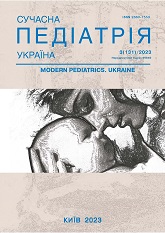Difficulties in diagnosing Kimerly’s anomaly (own clinical observation)
DOI:
https://doi.org/10.15574/SP.2023.131.121Keywords:
atlant, vertebral artery, posterior arch of the atlant, anomalyAbstract
Kimmerle’s anomaly is characterized by the presence of a bony arch of congenital or secondary origin in the structure of the first cervical vertebrae, which restricts the movement of the vertebral artery and causes its compression. This pathology belongs to craniovertebral malformations - congenital anatomical defects of the structure of the junction of the skull with the first cervical vertebra. Kimerly’s anomaly is diagnosed in approximately 12-30% of the population, causing vertebral artery syndrome, which is the cause of chronic ischemia in the posterior parts of the brain.
Purpose - to describe the clinical case of Kimmerle’s anomaly in a teenager as an example of a long diagnostic search for this pathology.
Clinical case. A 9-year-old girl complained of frequent headaches accompanied by vomiting. Similar conditions occurred every 3-4 weeks. Gastroenterological and neurological factors were not detected. The conditions were relieved by sleep, and drug therapy was not effective. During puberty, such attacks became less frequent and later disappeared. At the age of 16, the girl began to complain of neck pain, recurrent migraines, sharp «shooting» pain in the ear, accompanied by a buzzing sound, ringing, later joined by syncopal states, gait instability, and facial muscle weakness. An X-ray of the craniovertebral junction revealed Kimmerle’s anomaly. The patient’s condition improved with the use of the Shantz collar and constant physical therapy and neuroprotective therapy.
Conclusions. Kimmerle’s anomaly can be asymptomatic and incidental, but in younger patients with a combination of neuro-otolaryngological symptoms and drop attacks, this pathology should be excluded. When taking anamnesis, attention should be paid to the chronology and conditions of symptom onset, as well as the patient’s medical history.
The research was carried out in accordance with the principles of the Helsinki Declaration. The informed consent of the patient was obtained for conducting the studies.
No conflict of interests was declared by the authors.
References
Afsharpour S, Hoiriis KT, Fox RB, Demons S. (2016). An anatomical study of arcuate foramen and its clinical implications: a case report. Chiropractic & Manual Therapies. 24: 4. https://doi.org/10.1186/s12998-016-0082-2; PMid:26811743 PMCid:PMC4724954
Aktas AR, Erkmen C, Ozdol C, Cetın M, Parpar T, Ustun ED et al. (2015). Variations of Sulcus Arteria Vertebralis and Correlation with Clinical Symptoms. J Clin Analit Med. 6; 6: 830-834.
Chitroda PK, Katti G, Baba IA, Najmudin M, Ghali SR, Kalmath VJB. (2013). Ponticulus posticus on the posterior arch of atlas, prevalence analysis in symptomatic and asymptomatic patients of gulbarga population. J Clin Diagn Res. 7; 12: 3044-3047. https://doi.org/10.7860/JCDR/2013/6795.3847; PMid:24551723 PMCid:PMC3919343
Holovatskyi AS, Cherkasov VH, Sapin VR, Parakhin AI. (2009). Human anatomy in three volumes. Volume Three. Vinnytsia: New Book: 376.
Karau PB, Ogengo JA, Hassanali J, Odula P. (2010). Anatomy and prevalence of atlas vertebrae bridges in a Kenyan population: An osteological study. Clin Anat. 23: 649-653. https://doi.org/10.1002/ca.21010; PMid:20533509
Koutsouraki E, Avdelidi E, Michmizos D, Kapsali SE, Costa V, Baloyannis S. (2010). Kimmerle's anomaly as a possible causative factor of chronic tension-type headachesand neurosensory hearing loss: case report and literature review. Int J Neurosci. 120: 236-239. https://doi.org/10.3109/00207451003597193; PMid:20374094
Kumar BS, Panneer SG. (2016). Arcuate foramen of atlas vertebra. Innovare journal of medical science. 4; 3: 22-24.
Lvov I, Lukianchikov V, Grin A, Sytnik A, Polunina N, Krylov V. (2017). Minimally invasive surgical treatment for Kimmerle anomaly. J Craniovert Jun Spine. 8: 359-363. https://doi.org/10.4103/jcvjs.JCVJS_73_17 PMid:29403250 PMCid:PMC5763595
Md. Jawed Akhtar, Nasreen Fatima, Ritu, Vinod Kumar. (2015). A morphological study of ponticuli of the human atlas vertebrae and its clinical significance. Int J Anat Res. 3; 4: 1597-1602. https://doi.org/10.16965/ijar.2015.296
Tubbs RS, Johnson PC, Shoja MM, Loukas M, Oakes WJ. (2007). Foramen arcuale: anatomical study and review of the literature. J Neurosurg Spine. 6: 31-34. https://doi.org/10.3171/spi.2007.6.1.6; PMid:17233288
Downloads
Published
Issue
Section
License
Copyright (c) 2023 Modern pediatrics. Ukraine

This work is licensed under a Creative Commons Attribution-NonCommercial 4.0 International License.
The policy of the Journal “MODERN PEDIATRICS. UKRAINE” is compatible with the vast majority of funders' of open access and self-archiving policies. The journal provides immediate open access route being convinced that everyone – not only scientists - can benefit from research results, and publishes articles exclusively under open access distribution, with a Creative Commons Attribution-Noncommercial 4.0 international license (СС BY-NC).
Authors transfer the copyright to the Journal “MODERN PEDIATRICS. UKRAINE” when the manuscript is accepted for publication. Authors declare that this manuscript has not been published nor is under simultaneous consideration for publication elsewhere. After publication, the articles become freely available on-line to the public.
Readers have the right to use, distribute, and reproduce articles in any medium, provided the articles and the journal are properly cited.
The use of published materials for commercial purposes is strongly prohibited.

